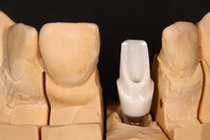
With telescopes, we work on teflon caps 0.2 mm thick. These caps serve us as an indirect telescope and provide an ideal friction work for many years.

At the request of our customers, we make zirconium connectors individual with the foundation of titanium. These connectors are made with the majority of implant systems available on the market.

With our system, CAD/CAM we are able to perform highly esthetic temporary crowns while ensuring perfect fitting and the formation of soft tissue.
The primary task of the CAD-CAM technology is to reduce the time and costs of production, while increasing the accuracy of producing the foundation/element significantly. A very important result of the CAD-CAM application at the dental laboratory is the complete departure from the traditional cast method (lost-wax waxing), which reduces hazards for the health of employees and the natural environment, by eliminating the dusty refractory masses, fumes of burnt wax and the application of aluminium oxide particles. The Dental CAD-CAM system comprises two stages, which are connected with the milling machine and a furnace for the sinterization of zirconium oxide.
The first stage – CAD (Computer Aided Design) – involves a scan that gives the basis for the consecutive designing and a programme with tools dedicated exclusively to designing either finished prosthetic fillings or a structural framework of prosthetic foundations. The system comprises an optical scanner that creates a virtual working model with a cloud of points with the repeatable accuracy of 15 microns. This very high repeatability of accuracy is obtained owing to the application of a special technology of converting the expansion of the scanner parts. Electronic temperature sensors analyse the ambient temperature on the ongoing basis, which provides the revision of the scanning points coordinates.
The generated virtual working model can be used for a number of prosthetic projects. The programme used by our laboratory in virtual modelling features the tools to produce quickly interim fillings of the anatomic shapes, ceramic implant connections, zirconium and composite foundations as well as wax and acryl structures for casting. The whole modelling process is controlled by special monitoring software, which analyses the correctness of scanning and modelling. If any irregularities are detected, the programme reports an error and gives the solution, preventing the consecutive stages before the issue is resolved. The control of the dedicated qualities of the material is very important, such as the resistance to bending, the specification of space for the dental cement and the articulation control.
The next stage involved in the CAD-CAM process is CAM (Computer Aided Manufacturing). This stage determines the precision of recreating the designed model. This purpose is fulfilled by the programme for computation and the milling machine with computer control. The advantage of our CAM is its production potential – every type of design has its attributed type of processing. Competitive systems apply a uniform type of processing for all types of designs. Correctly prepared processing enables to use the full potential of a milling machine.
The system works closely with the milling machine. Our machine can compete successfully with the leading brands on the global market. Owing to the use of DC servomotors and the control that generates circular, rather than straight movements, it gives the repeatable accuracy of 5μm and shortens the working time by 2/3 compared to competitive devices.